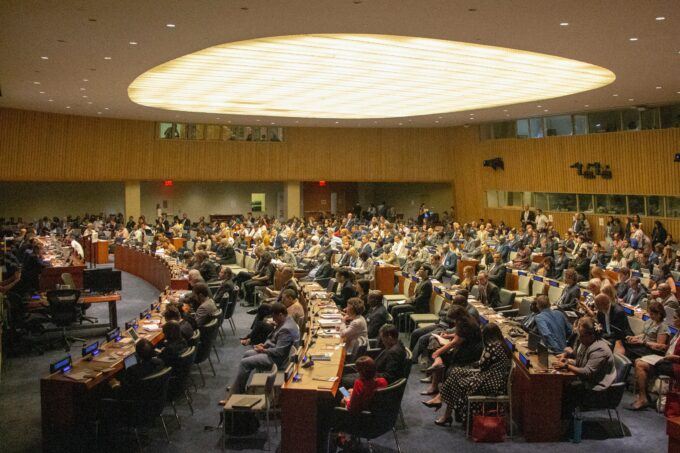
Image by Matthew TenBruggencate.
The fundamental problem we face today in world affairs is our failure to adjust our international institutions to the imperative needs of a rapidly evolving age.
The UN Secretary-General said as much last September when in a speech before the General Assembly he noted: “We cannot effectively address problems as they are if institutions don’t reflect the world as it is.”
The world has become far more complex than it was in 1945 when the current global governance system, based primarily on the UN Charter, was created.
This system of international cooperation is no longer fit for purpose. It struggles to cope with the multiple unresolved crises we face, often because it lacks the appropriate jurisdiction, adequate resources, and the conceptual framework to effectively diagnose the problems and bring about credible solutions, and because it is deemed fundamentally unfair.
And so, we move on towards a potentially catastrophic future of accelerating climate change, the continued unraveling of our nuclear order, rising and destructive nationalisms, increasing conflict, more frequent pandemics, and an economic paradigm that cannot deliver well being for all.
The UN Charter was adopted 79 years ago, on June 26, 1945. So, here’s a thought experiment: If we were to start from a completely blank page, with no prior mistakes to correct or historical context to maintain, what system of international governance would we design and how might it function?
Adaptation and reinvention are a part of the natural course of things. One can both support the UN for its achievements and acknowledge the need for its transformation. Our call to reform the UN comes from our desire to see it survive and thrive.
The Charter was always meant to be a living document. In adopting it in 1945, then U.S. President Harry Truman made this clear: “This Charter will be expanded and improved as time goes on. No one claims that it is now a final or a perfect instrument. It has not been poured into any fixed mold. Changing world conditions will require readjustments.”
The Charter’s own Articles 108 and 109 were deliberately drafted to institutionalize the possibility of its evolution over time. The main issue to be addressed by these articles from the very inception of the UN was the veto in the Security Council. This should be seriously reexamined, as recommended in a recent report of an expert body convened by the Secretary-General. But so, too, could the Charter place a greater emphasis on climate change, on which it is silent; it could articulate the rules of a World Parliament to make it more representative; it could strengthen the UN’s ability to enforce decisions; provide more predictable financing, and better engage the world’s citizens in international decision-making.
The most common argument against updating the Charter is that with today’s fraught geopolitical landscape, we risk ending up with something worse
First, there will never be a perfect time. As the saying goes, the best time to plant a tree was 20 years ago. The second-best time is now.
Second, Charter reform will take years. The mood will change in time. But we need to start the process, or at the very least, the conversation.
Third, Charter reform would address the very issues that make many nations so mistrustful, including perceived double standards in the application of international law and a global governance system that privileges the interests of a few powerful countries at the expense of others. Creating a fairer playing field would incentivize countries to engage in good faith.
And finally, yes, there are risks involved in UN Charter reform, but there are even greater risks in continuing our current path.
This is why the exercise of imagining a new start, from scratch, could be helpful. Imagination isn’t subject to a veto (Charter reform requires that all five permanent members consent to the change), nor is it bound by the current political loggerheads which can make even marginal change seem extremely difficult.
Imagination can open the door to ideas both great (such as questioning the role of state sovereignty in a world of global interdependence); and small (like requiring that the General Assembly hold a session whenever a veto is used in the Security Council).
What we must avoid, regardless of the fraught political moment and our own trepidation, is to delay conceiving of something new out of a misplaced deference to a system that is not delivering credible solutions to existential threats.
We would do well to imagine what a new Charter might look like (as some have already begun doing); what principles it would be built on, what institutions it would give rise to, and how it could inspire the world to come together in a new shared endeavor. Imagine a new Charter drawn up by a far more representative display of the world’s many cultures and governments (only 51 countries existed when the current Charter was drafted whereas there are now some 200 sovereign nation-states. Once we have dared to imagine, we may be better equipped to bring some of the necessary changes into being.
The stakes could not be higher. A new path is needed. The question is whether we craft it intentionally, as a matter of conscious choice, or whether we suffer the horrific consequences of failure to act.
The UN Charter was always meant to be a living document. Perhaps now is the time to breathe some new life into it.
The post Breathing New Life into the UN Charter appeared first on CounterPunch.org.
This content originally appeared on CounterPunch.org and was authored by Dan Perell - Heba Aly.
Dan Perell - Heba Aly | Radio Free (2024-07-09T05:17:11+00:00) Breathing New Life into the UN Charter. Retrieved from https://www.radiofree.org/2024/07/09/breathing-new-life-into-the-un-charter/
Please log in to upload a file.
There are no updates yet.
Click the Upload button above to add an update.